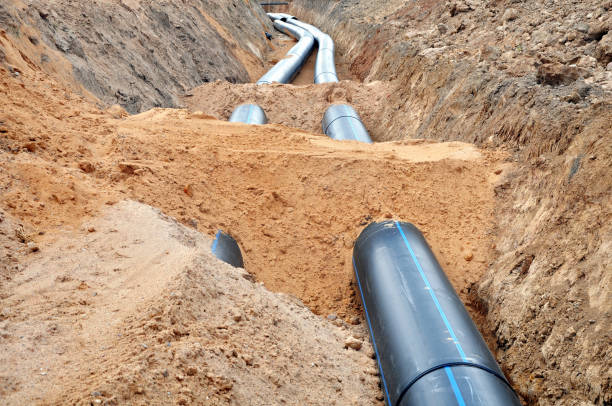Key Takeaways
- Underground trenching is the foundation of every modern construction project.
- It provides safe housing for fiber, power, and utility lines.
- Professional trenching prevents damage, enhances aesthetics, and supports future infrastructure growth.
- Phoenix Communications delivers precision trenching services that meet strict safety and engineering standards.
When it comes to new construction projects, one of the most critical yet often overlooked steps is what happens below the surface. Underground trenching plays a major role in ensuring reliable connectivity, electrical infrastructure, and communication networks that power modern buildings. At Phoenix Communications Inc., we specialise in fiber-optic construction, maintenance, and engineering, which means we understand exactly how vital proper trenching is to long-term performance and safety.
What Is Underground Trenching?

Underground trenching is the process of excavating narrow, deep channels in the ground to install essential utilities such as fiber-optic cables, electrical wiring, water lines, and gas conduits. These trenches are carefully engineered to protect the cables from environmental damage while keeping them accessible for future maintenance.
Depending on the project, trenching can range from a few inches to several feet deep. Advanced equipment—such as chain trenchers, vibratory plows, and directional drills—is used to achieve precise depths and clean edges, minimizing disruption to surrounding areas.
Why Underground Trenching Is Essential for New Construction
1. Enables Reliable Fiber and Power Infrastructure
Every new residential or commercial development depends on consistent communication and electrical systems. Underground trenching allows safe, stable installation of fiber-optic networks, ensuring high-speed data transmission and uninterrupted connectivity.
2. Protects Utilities from Damage
By burying utilities underground, cables are shielded from weather, vandalism, and accidental impact. This not only extends their service life but also reduces downtime caused by external elements like storms or heavy machinery.
3. Improves Aesthetics and Space Management
Trenching keeps utilities hidden, improving the appearance of new communities and developments. With cables and lines placed underground, developers can create cleaner, more modern streetscapes without overhead wires.
4. Supports Future Growth
Properly planned trenching accommodates future upgrades. Phoenix Communications designs every trenching layout with scalability in mind—so adding new fiber lines, conduits, or systems later doesn’t require major disruption.
5. Ensures Safety and Compliance
Professional trenching adheres to engineering codes, depth standards, and local regulations. Our experienced team performs soil assessments, marks existing utilities, and ensures every excavation meets compliance to avoid costly safety issues or violations.
Trenching Methods We Use
At Phoenix Communications Inc., we use several specialized methods based on site conditions:
- Open Trenching: The traditional method involving excavation with mechanical or chain trenchers—ideal for large-scale or rural installations.
- Directional Drilling: A trenchless approach that allows for underground installation beneath roads, sidewalks, or existing structures with minimal disturbance.
- Micro-Trenching: A narrow, shallow cut used for urban fiber deployment, fast, efficient, and less invasive.
Each project begins with a site evaluation and engineering plan to determine which technique ensures the most durable, cost-effective result.
Why Choose Phoenix Communications Inc.
As a leader in fiber-optic construction and maintenance, Phoenix Communications combines cutting-edge technology with decades of field experience. Our trenching services are designed for accuracy, safety, and long-term reliability, whether for public infrastructure, private developments, or utility expansions.
We coordinate every phase, from engineering design to cable installation and fiber optic splicing, to ensure seamless integration with your construction schedule. Our crews are trained, certified, and equipped to handle both standard and complex trenching environments.
Whether you’re developing a new subdivision, upgrading municipal infrastructure, or expanding commercial connectivity, Phoenix Communications Inc. has the expertise to deliver top-tier underground trenching and fiber-optic installation services.
Contact us today to schedule a consultation or request a site evaluation from our engineering team.
Frequently Asked Questions
1. What is the purpose of underground trenching in new construction?
Underground trenching provides a protected pathway for essential utilities like fiber-optic cables, electrical lines, and water pipes. It ensures that infrastructure is safely installed below the surface, reducing exposure to weather, damage, and interference while allowing for easier maintenance and upgrades in the future.
2. How deep should an underground trench be for fiber-optic cables?
The depth of a fiber-optic trench varies depending on local codes and project type, but most installations range between 12 to 48 inches deep. At Phoenix Communications Inc., our engineering team follows all regulatory standards and performs on-site assessments to determine the ideal depth for long-term safety and performance.
3. What’s the difference between trenching and directional drilling?
Trenching involves excavating an open channel in the ground to place cables or conduits, while directional drilling is a trenchless method that bores underground horizontally. Trenching is typically used in open areas or new construction sites, whereas directional drilling is preferred in urban settings or under existing infrastructure like roads and sidewalks.
